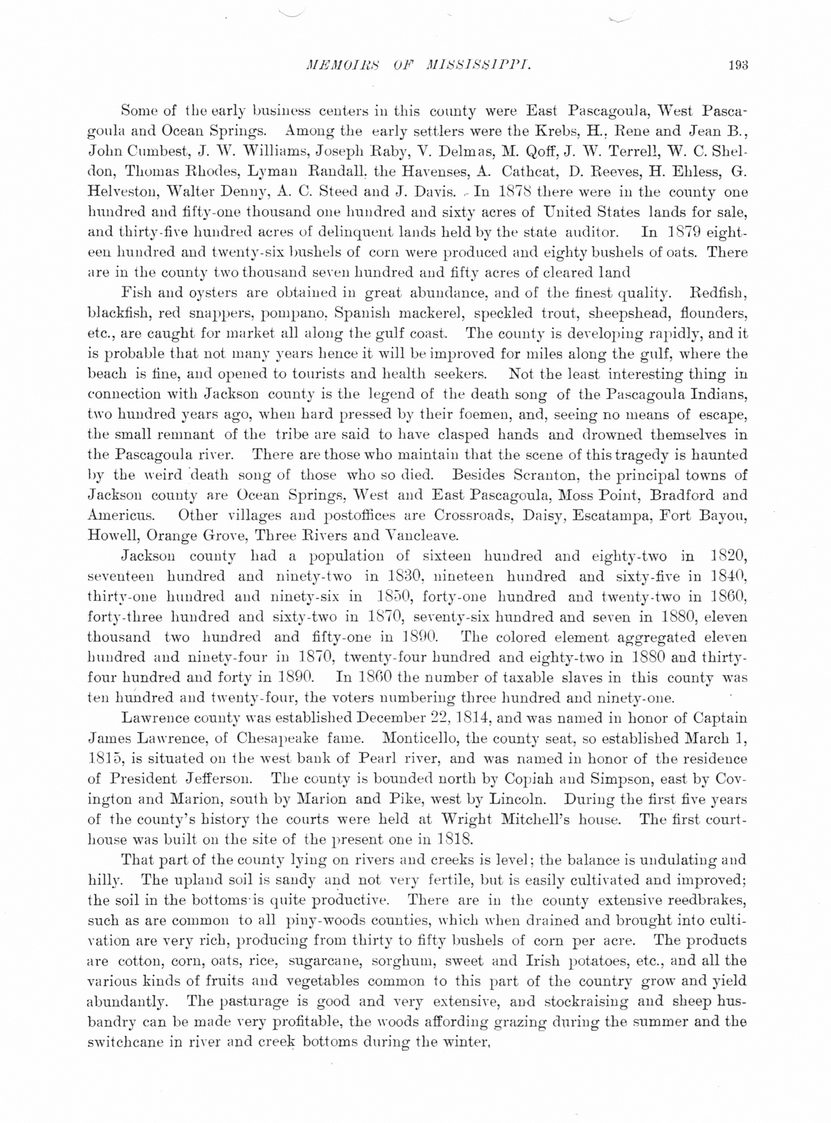This text was obtained via automated optical character recognition.
It has not been edited and may therefore contain several errors.
MEMOIRS OF MISSISSIPPI. 193 Some of the early business centers in this county were East Pascagoula, West Pascagoula and Ocean Springs. Among the early settlers were the Krebs. H.. Rene and Jean B., John Cumbest, J. W. Williams, Joseph Raby, V. Delmas, M. Qoff, J. W. Terrell, W. C. Sheldon, Thomas Rhodes, Lyman Randall, the Havenses, A. Cathcat, D. Reeves, H. Ehless, G. Helveston, Walter Dennv, A. C. Steed and J. Davis. . In 1878 there were in the county one hundred and fifty-one thousand one hundred and sixty acres of United States lands for sale, and thirty-five hundred acres of delinquent lands held by the state auditor. In 1879 eighteen hundred and twenty-six bushels of corn were produced and eighty bushels of oats. There are in the county two thousand seven hundred and fifty acres of cleared land Fish and oysters are obtained in great abundance, and of the finest quality. Redfish, blackfish, red snappers, pompano. Spanish mackerel, speckled trout, sheepshead, flounders, etc., are caught for market all along the gulf coast. The county is develo})ing rapidly, and it is probable that not many years hence it will be improved for miles along the gulf, where the beach is fine, and opened to tourists and health seekers. Not the least interesting thing in connection with Jackson county is the legend of the death song of the Pascagoula Indians, two hundred years ago, when hard pressed by their foemeu, and, seeing no means of escape, the small remnant of the tribe are said to have clasped hands and drowned themselves in the Pascagoula river. There are those who maintain that the scene of this tragedy is haunted by the weird death song of those who so died. Besides Scranton, the principal towns of Jackson county are Ocean Springs, West and East Pascagoula, Moss Point, Bradford and Americus. Other villages and postoffices are Crossroads, Daisy, Escatampa, Fort Bayou, Howell, Orange Grove, Three Rivers and Yancleave. Jackson county had a population of sixteen hundred and eighty-two in 1820, seventeen hundred and ninety-two in 1830, nineteen hundred and sixty-five in 1840, thirty-one hundred and ninety-six in ISiiO, forty-one hundred and twenty-two in I860, forty-three hundred and sixty-two in 1870, seventy-six hundred and seven in 1880, eleven thousand two hundred and fifty-one in 1890. The colored element aggregated eleven hundred and ninety-four in 1870, twenty-four hundred and eighty-two in 1880 and thirty-four hundred and forty in 1890. In 1800 the number of taxable slaves in this county was ten hundred and twenty-four, the voters numbering three hundred and ninety-one. Lawrence county was established December 22, 1814, and was named in honor of Captain James Lawrence, of Chesapeake fame. Monticello, the county seat, so established March 1, 1815, is situated on the west bank of Pearl river, and was named in honor of the residence of President Jefferson. The county is bounded north by Copiah and Simpson, east by Covington and Marion, south by Marion and Pike, west by Lincoln. During the first five years of the county’s history the courts were held at Wright Mitchell’s house. The first courthouse was built on the site of the present one in 1818. That part of the county lying on rivers and creeks is level; the balance is undulating and hilhr. The upland soil is sandy and not very fertile, but is easily cultivated and improved; the soil in the bottoms is quite productive. There are in the county extensive reedbrakes, such as are common to all piny-woods counties, which when drained and brought into cultivation are very rich, producing from thirty to fifty bushels of com per acre. The products are cotton, corn, oats, rice, sugarcane, sorghum, sweet and Irish potatoes, etc., and all the various kinds of fruits and vegetables common to this part of the country grow and yield abundantly. The pasturage is good and very extensive, and stockraising and sheep husbandry can be made very profitable, the woods affording grazing during the summer and the switchcane in river and creek bottoms during the winter,

Hancock County 1 Memoirs-of-Mississippi-excerpt-(004)